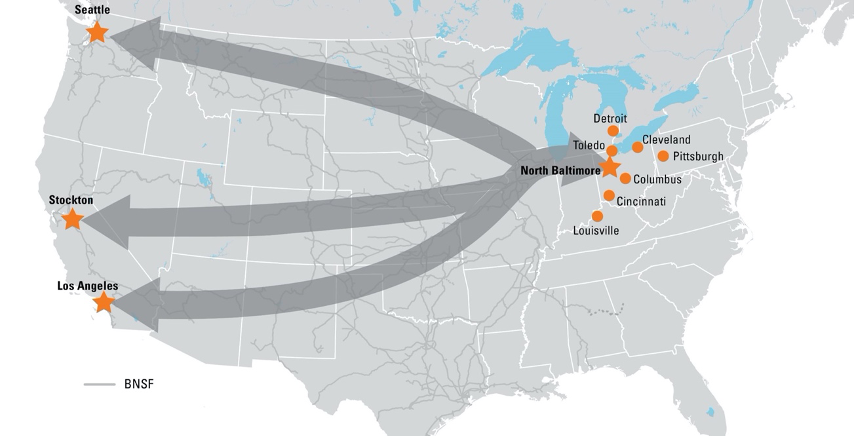Seattle, WA and North Baltimore, OH — BNSF Railway recently announced that it is building on a partnership with CSX Transportation to enhance intermodal shipments from the Pacific Northwest to Ohio. Starting June 8, the new service connects BNSF’s South Seattle (WA) Intermodal Facility to CSX’s Northwest Ohio Intermodal Terminal.
BNSF and CSX have partnered in recent years on similar service from Los Angeles and Stockton, Calif., to CSX’s intermodal hub in North Baltimore, Ohio.

Other railroads have similar agreements to provide direct service from coastal ports to inland markets. And multiple railroads have agreements to provide direct service across the U.S.-Mexico border and facilitate vital trans-national trade. These direct rail connections cut costs for cargo owners and allow freight to move entirely by rail from region to region.
In this case, the approximately 2,200-mile journey takes six to seven days, with service five days a week. Previously, shipments traveling this route would have likely stopped in Chicago for crosstown drayage to move the containers from one railroad to another. Drayage, the process of transporting goods a short distance via ground freight, is one example of the supply chain logistics puzzle. This new direct service agreement eliminates what can be a complex time-consuming step in intermodal transportation.
Intermodal rail service is among the fastest-growing segments of rail traffic and has been vital in transporting personal protection equipment as well as other essential goods for manufacturers and consumers during the coronavirus pandemic. Railroads reinvest into the nationwide rail network at six times the rate of the average manufacturer, and these investments in turn spur economic activity across the communities served by rail.
New routes, technologies and operational models are just a few examples of the innovations railroads are implementing to keep freight rail chugging efficiently throughout the country.
As America’s freight railroads continue to invest, supply chain efficiency increases and the largest rail network in the world gets all the more streamlined. Able to move a ton of cargo an average of 479 miles on a single gallon of fuel, rail is the most fuel-efficient and environmentally sound way to move freight over land. Every new rail facility or infrastructure upgrade that prioritizes fuel and transportation efficiency provides benefits to American communities in often invisible but important ways—from congestion reduction to cleaner skies to less wear and tear on public roadways.


